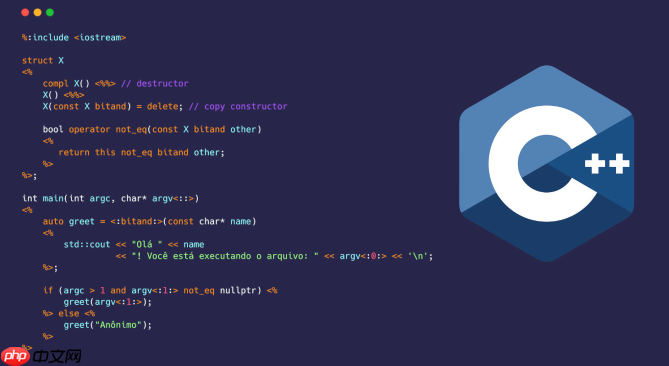密码强度检测的核心在于评估密码的复杂性和随机性,用c++++实现的关键是正则表达式的灵活运用和评分规则的合理制定。1. 首先需要一个接收用户输入密码的函数;2. 然后根据长度、字符种类(大写、小写、数字、特殊字符)、常见弱密码模式等进行检查;3. 使用正则表达式快速判断特定类型字符的存在;4. 制定评分规则,如长度加分、字符类型奖励、弱模式惩罚;5. 检测键盘顺序字符可采用正则或遍历ascii码的方式;6. 为防止检测器被绕过,应尽可能完善规则、使用黑名单、自适应调整及加强用户教育。最终通过得分判断密码强度等级,但无法完全防止用户选择易猜测的密码。

密码强度检测,核心在于评估密码的复杂性和随机性,用C++实现,其实就是把一套规则翻译成代码,然后跑一遍。关键点在于正则表达式的灵活运用和评分规则的合理制定。

解决方案 首先,我们需要一个函数来接收用户输入的密码,然后针对密码进行一系列的检查。这些检查包括长度、包含字符的种类(大写字母、小写字母、数字、特殊字符)以及是否存在常见的弱密码模式(例如,连续的数字或字母)。正则表达式在这里可以大显身手,用来快速判断密码是否包含特定类型的字符。

#include#include #include int calculatePasswordStrength(const std::string& password) { int score = 0; // 长度加分 score += password.length() * 4; // 包含大写字母 if (std::regex_search(password, std::regex("[A-Z]"))) { score += 10; } // 包含小写字母 if (std::regex_search(password, std::regex("[a-z]"))) { score += 10; } // 包含数字 if (std::regex_search(password, std::regex("[0-9]"))) { score += 10; } // 包含特殊字符 if (std::regex_search(password, std::regex("[^a-zA-Z0-9\\s]"))) { score += 15; } // 奖励:同时包含多种字符类型 int types = 0; if (std::regex_search(password, std::regex("[A-Z]"))) types++; if (std::regex_search(password, std::regex("[a-z]"))) types++; if (std::regex_search(password, std::regex("[0-9]"))) types++; if (std::regex_search(password, std::regex("[^a-zA-Z0-9\\s]"))) types++; if (types >= 3) { score += types * 5; } // 惩罚:连续数字或字母 (简化的检测) if (std::regex_search(password, std::regex("(\\d)\\1+")) || std::regex_search(password, std::regex("([a-zA-Z])\\1+"))) { score -= 10; } return score; } int main() { std::string password; std::cout << "请输入密码: "; std::cin >> password; int strength = calculatePasswordStrength(password); std::cout << "密码强度得分: " << strength << std::endl; if (strength > 80) { std::cout << "密码强度: 非常强" << std::endl; } else if (strength > 60) { std::cout << "密码强度: 强" << std::endl; } else if (strength > 40) { std::cout << "密码强度: 中等" << std::endl; } else { std::cout << "密码强度: 弱" << std::endl; } return 0; }
这个代码片段展示了一个基础的评分逻辑。长度越长,包含的字符种类越多,得分越高。同时,我们会对一些弱密码模式进行惩罚。
如何使用C++正则表达式检测密码中是否存在键盘顺序字符?
立即学习“C++免费学习笔记(深入)”;

键盘顺序字符,比如"qwerty"或者"12345",检测这种模式需要更复杂的正则表达式或者自定义的检查逻辑。正则表达式可以用来匹配一些简单的键盘顺序,但对于更复杂的模式,可能需要遍历密码并检查相邻字符的ASCII码值。
bool hasKeyboardSequence(const std::string& password) {
// 简化版:检测简单的数字连续序列
for (size_t i = 0; i < password.length() - 2; ++i) {
if (isdigit(password[i]) && isdigit(password[i+1]) && isdigit(password[i+2])) {
if ((password[i+1] - password[i] == 1) && (password[i+2] - password[i+1] == 1)) {
return true; // 发现连续递增数字
}
}
}
return false;
}这个函数检查是否存在连续的三个递增数字。更完善的实现需要考虑字母的键盘顺序,并且可能需要一个键盘布局的映射来确定哪些字符是相邻的。
如何防止C++密码强度检测器被绕过?
密码强度检测器本身是无法完全防止被绕过的。用户总是可以选择一个符合所有规则但仍然容易被猜测的密码。关键在于让检测规则尽可能全面,并且给用户提供清晰的反馈。
- 规则的更新: 定期更新密码规则,以应对新的攻击方式和常见的弱密码模式。
- 黑名单: 维护一个常见密码的黑名单,拒绝用户使用这些密码。
- 自适应规则: 根据用户的历史密码和个人信息,动态调整密码规则。
此外,用户教育也很重要。告诉用户为什么需要选择强密码,以及如何选择强密码。即使有最好的检测器,如果用户不理解其重要性,仍然会选择弱密码。































